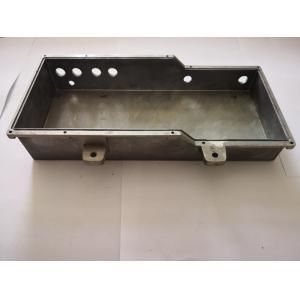

Add to Cart
Automobile end cover mirror polished aluminum die casting
Aluminum Die Casting Subdivision
The popularity of aluminum has expanded to many applications around
the world today, mainly because of its unique features (such as
light weight) and winning a competitive market share. Corrosion
resistance, high conductivity and thermal conductivity, high
stability and high tensile strength of complex shapes. The
transportation industry is the largest end-use sector in the
industry. The increasingly stringent emission regulations of
government regulatory agencies and consumer demand for more
fuel-efficient cars are gradually becoming a necessary condition
for aluminum castings. An example of increased operations in the
industry includes replacing steel components in vehicles with
lightweight, high-quality aluminum to improve fuel efficiency.
Another industry on demand for aluminum die castings includes the
construction industry in developing economies, especially the
Asia-Pacific region. Aluminum die castings are related to the
creation of products, including windows, cladding, curtain walls,
prefabricated buildings, store partitions and accessories.
Moreover, aluminum die-casting products are also used in aerospace
operations or aircraft around the world. As aircraft sizes and
population proportions continue to grow, the aviation industry
hopes to produce higher-density and higher-quality products for
these airframe components at a lower cost.
Aluminum die casting process
Aluminum die-casting process The casting process realizes steel
molds that can usually produce thousands of castings in rapid
succession. The mold must be made in at least two parts to allow
the casting to be removed. The casting cycle begins with the die
casting machine clamping the two mold halves tightly together.
Molten aluminum is injected into the cavity where it solidifies
quickly. These parts are firmly installed in the machine and
arranged so that one part is fixed and the other is movable.
Separate the mold halves and eject the casting. Die-casting molds
can be simple or complex, depending on the complexity of the
casting, with movable sliders, cores or other parts. Most machines
use a mechanism actuated by a hydraulic cylinder to achieve
locking. Others use direct acting hydraulic pressure. Large or
small die casting machine.
What are the advantages of aluminum die casting?
There are many reasons why aluminum is the most common non-ferrous
metal in the world. As a lightweight metal, the most common reason
for using aluminum die castings is that it can make very
lightweight parts without sacrificing strength. Compared with other
non-ferrous metal materials, aluminum die castings also have more
surface finish options and can withstand higher operating
temperatures. Aluminum die castings are corrosion resistant, highly
conductive, and have good stiffness and strength to weight ratio.
The aluminum die-casting process is based on rapid production.
Compared with alternative casting processes, this process can
produce a large number of die-casting parts very quickly, more
economically and efficiently. Aluminum die castings have become the
favored choice of global buyers. The characteristics and advantages
of aluminum die castings include:
Lightweight and durable
Good weight ratio
Strong corrosion resistance
Excellent conductivity
Fully recyclable and reusable in production
Aluminum die casting parameters
| Specification | Customized,customer required,customer's drawings |
| Material | ADC12/ADC10/A380/A383/A390/413/AllSi9Cu3/AlSi10Mg,etc. |
| Application | Automobile, agricultural machinery, furniture, |
| construction, home appliances, electronics. | |
| Process | High pressure die casting or Semi-solid thixoforming |
| Machining | CNC machining center, CNC lathe |
| Casting tolerance | IT4 - IT6 |
| Machining tolerance | +/- 0.005mm,ISO2768-f |
| Standard | DIN,ASTM,GOST,ISO,BS |
| Heat treatment | Annealing treatment,solution treatment ,T1,T2,T3,T4,T5,T6 |
| Unit weight | 5g-30kg |
| Dimensions | <=1500mm |
| Die casting machine specification | 150T-3000T |
| Certificate | ISO9001, TS16949,ISO1400,RoHS |
| Finish | Plating,Painting,Powder Coating,Polishing, Stoving Varnish,Anodizing |
| Quality control | FEMA,PPAP,APQP,Control Plan,MSA, |
| Certificates for all requirements | |
| Test reports for every delivery | |
| Service | Weekly report,Key node report,Any questions will be answered within 24 hours. |
